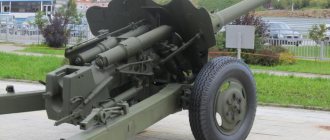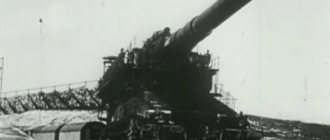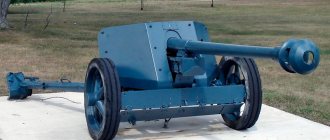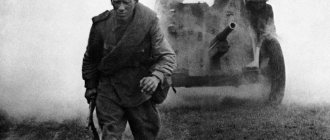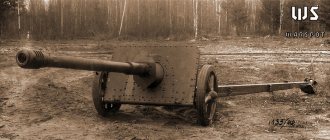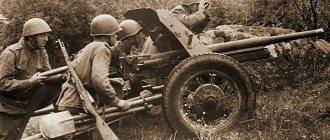The Second World War demonstrated that the development of anti-tank artillery was reaching a dead end. The protection of tanks increased so much that light and mobile guns of relatively small caliber soon turned into bulky systems with a caliber of over 100 mm.
However, for the first time after the war, the development of anti-tank guns did not stop - before the advent of guided missiles, there was simply no other means of combating armored vehicles. One of the first post-war guns was the Soviet D-48 cannon of 85 mm caliber. Its development was led by the famous designer Fyodor Petrov.
History of creation
One of the best Soviet wartime anti-tank guns was the 57 mm ZiS-2. It successfully combined high armor penetration and low weight. The 100 mm BS-3 gun was even more powerful, but at the same time it was almost four times heavier. To combat promising tanks, a weapon of greater power was required, but a further increase in mass was undesirable.
As a result, Petrov’s team decided to use the 85 mm caliber, but at the same time boost the ballistics by using a cartridge case and a powder charge from 100 mm ammunition. To further increase the initial velocity of the projectile, the D-48's barrel length was additionally increased. The prototype was built in 1948.
The first results of field tests showed the ineffectiveness of the muzzle brake.
After the development of a new device and fine-tuning in 1950, the gun was presented to the troops. The gun was put into service in 1953, but serial production began only 2 years later.
Self-propelled anti-tank guns[edit]
Main articles: Tank destroyer and self-propelled guns
See also: Panzerjäger, Jagdpanzer, and Self-propelled gun.
British Archer tank destroyer, based on the Valentine tank.
Although towed anti-tank guns were still horse drawn or towed by trucks, they were originally much lighter and more portable than field guns, making them well suited for infantry maneuvers. [17] However, as guns increased in size and caliber, they became increasingly heavy and bulky, limiting their role to static defense. As a result, during World War II, both sides were forced to make anti-tank guns self-propelled, which greatly increased their mobility. [17]
The first self-propelled anti-tank guns were simply belated attempts to use older tanks such as the Panzerjäger I, which was a 4.7 cm Pak(t) mated to a Panzerkampfwagen I chassis. [18] The trend continued with older tanks being available in large numbers quantity for conversion to self-propelled guns when they were replaced by heavier and better armed (and armored) tanks. [18] Although only a temporary solution, these initial experiments were so successful that they spawned an entire class of new vehicles: dedicated tank destroyers. [18]
Tank destroyers had some advantages over towed anti-tank guns, since the static mounting of the gun sacrificed camouflage and surprise after the first shot, but the same gun mounted on a tracked or wheeled chassis could open fire and throw the tank formation into significant disarray before quickly escaping. to repeat the same tactics elsewhere. [19] The introduction of tank destroyers also ended the traditional tactic of suppressing anti-tank gun batteries through heavy artillery bombardment, as their crews were now well protected by armor. [19] However, they are not without a number of disadvantages, namely, they represent a much larger target than the towed gun, additional responsibilities for vehicle maintenance and logistics, as well as limited space in which the crew had to operate and place all available they have ammunition. [19]
By the end of the war, dedicated tank destroyers had been supplanted by tanks that were just as effective at destroying other tanks, leaving little incentive to continue developing them independently. [17] However, like towed anti-tank rifles, they were widely exported and were still in service with several armies at the end of the 20th century. [16] [12]
Design
D-48 has a classic layout with a carriage with 2 sliding beds. The monoblock barrel is equipped with a 2-chamber active muzzle brake, which absorbs about 70% of the recoil energy. The shutter is a vertical wedge with a semi-automatic mechanism. Above the barrel there is a hydraulic recoil brake and a pneumohydraulic knurler. The lifting and turning mechanisms of the implement are screw-type and driven manually.
The D-48 wheels are unified with the vehicle components from the ZiS-5 truck. “Artillery” wheels differ from ordinary wheels by bullet-resistant tires filled with spongy rubber. The suspension of the chassis is torsion bar and is automatically switched off when the frames are moved apart. The beds are hollow box-shaped pipes with openers located at their ends.
If necessary, the relatively small mass of the gun allows it to be moved manually; to do this, a roller must be placed under the long barrel.
For direct fire, the K-1 open collimator sight is used; for more accurate aiming, an optical sight model OP-2 or OP-4 was used, giving a magnification of 5.5 times. For firing from closed positions, the open sight was supplemented with a Hertz PG-1 panorama. Some of the guns were equipped with night sights.
In service
Serbian "Rapier".
Cumulative shot to the gun (APU).
- Azerbaijan - 72 MT-12, as of 2022
- Armenia - 36 MT-12, as of 2016
- Bulgaria - 126 MT-12, as of 2016
- Georgia - 40 MT-12, as of 2022
- Kazakhstan - 68 T-12/MT-12, as of 2016
- Kyrgyzstan - 18 T-12/MT-12, as of 2016
- Moldova - 37 MT-12, as of 2016
- Mongolia - some, as of 2016
- Russia - 526 MT-12, (2000 T-12/MT-12 in storage), as of January 2016
- Turkmenistan - 60 T-12/MT-12, as of 2016
- Uzbekistan - 36 T-12/MT-12, as of 2016
- Ukraine - at least 500 T-12/MT-12, as of 2016
Former operators
- Algeria - 10 T-12, as of 2010
- Bosnia and Herzegovina - 155 T-12/MT-12, as of 2013
- Hungary
- GDR
- Iraq
- Poland
- USSR
- Yugoslavia
- Croatia - 133 T-12, as of 2010
- Montenegro - 36 MT-12, as of 2010
Ammunition
The main means of destroying tanks for the D-48 was the BR-372 projectile - a steel blank with armor-piercing and ballistic tips, containing a bursting charge of 50 g of hexane. BR-372 developed an initial speed of 1010 m/s. Normal armor penetration was 190 mm at a distance of 500 m, at a distance of 2 km it dropped to 145 mm.
Later, the ammunition load was replenished with the 3BK7 cumulative projectile - at any distance at an angle of 30⁰ it penetrated 190 mm of armor. The initial speed was lower than that of an armor-piercing projectile - 925 m/s. The OF-372 high-explosive fragmentation projectile contained 741 g of TNT, its initial speed was 1010 m/s at full charge and 770 at reduced charge. The fragmentation projectile was the only one for which a shot with a reduced powder charge was developed.
An excerpt characterizing the 85-mm anti-tank gun D-48
- Haven't been since last night. That’s right, we lost,” Lavrushka answered. “I already know that if they win, they’ll come early to brag, but if they don’t win until morning, that means they’ve lost their minds, and they’ll come angry.” Would you like some coffee? - Come on, come on. After 10 minutes, Lavrushka brought coffee. They're coming! - he said, - now there’s trouble. - Rostov looked out the window and saw Denisov returning home. Denisov was a small man with a red face, shiny black eyes, and black tousled mustache and hair. He had an unbuttoned mantle, wide chikchirs lowered in folds, and a crumpled hussar cap on the back of his head. He gloomily, with his head down, approached the porch. “Lavg’ushka,” he shouted loudly and angrily. - Well, take it off, you idiot! “Yes, I’m filming anyway,” Lavrushka’s voice answered. - A! “You’re already up,” Denisov said, entering the room. “A long time ago,” said Rostov, “I already went for hay and saw the maid of honor Matilda.” - That's how it is! And I puffed up, bg'at, like a son of a bitch! - Denisov shouted, without pronouncing r. - Such misfortune! Such misfortune! As you left, so it went. Hey, some tea! Denisov, wrinkling his face, as if smiling and showing his short, strong teeth, began to ruffle his fluffy black thick hair with both hands with short fingers, like a dog. “I didn’t dare go to this kg’ysa (the officer’s nickname),” he said, rubbing his forehead and face with both hands. – You can imagine, I didn’t give a single kag’ty, not a single, not a single kag’ty. Denisov took the lit pipe handed to him, clenched it into a fist, and, scattering fire, hit it on the floor, continuing to scream. - Sempel will give, pag'ol will beat; Sempel will give, pag'ol will beat. He scattered fire, broke the pipe and threw it away. Denisov paused and suddenly looked cheerfully at Rostov with his sparkling black eyes. - If only there were women. Otherwise, there’s nothing to do here, just like drinking. At least I could fight with it. - Hey, who's there? - he turned to the door, hearing the stopped steps of thick boots with the clanking of spurs and a respectful cough. - Sergeant! - said Lavrushka. Denisov wrinkled his face even more. “Skveg’no,” he said, throwing away a wallet with several gold pieces. “G’ostov, count, my dear, how much is left there, and put the wallet under the pillow,” he said and went out to the sergeant. Rostov took the money and, mechanically, putting aside and arranging old and new gold pieces in piles, began to count them. - A! Telyanin! Zdogovo! They blew me up suddenly! – Denisov’s voice was heard from another room. - Who? At Bykov’s, at the rat’s?... I knew,” said another thin voice, and after that Lieutenant Telyanin, a small officer of the same squadron, entered the room. Rostov threw his wallet under the pillow and shook the small, damp hand extended to him. Telyanin was transferred from the guard for something before the campaign. He behaved very well in the regiment; but they did not like him, and in particular Rostov could neither overcome nor hide his causeless disgust for this officer. - Well, young cavalryman, how is my Grachik serving you? - he asked. (Grachik was a riding horse, a carriage, sold by Telyanin to Rostov.)
Exploitation
The D-48 guns were not in production for long - only until 1957. The gun was produced in China a little longer.
Soviet D-48s were supplied in small quantities to the countries of the Warsaw Pact Organization, Chinese analogues were supplied to Pakistan and African countries.
The anti-tank value of the gun quickly faded away, but the system was not removed from service in the Soviet Union. According to some information, 85 mm guns were used during the first Chechen campaign. Currently, the gun is not in service with the Russian Army.
In 2016, a certain number of D-48s were in Mongolia and Mozambique. In addition, in 2015, Ukraine was going to reactivate the 85 mm guns available in warehouses for their use in the civil war.
Quotes [edit]
- Foss, Christopher (1977). Jane's Pocket Book of Towed Artillery
. New York: Collier. paragraph 45. ISBN 0020806000. OCLC 911907988. - https://survincity.com/2013/11/post-war-anti-tank-artillery-85-mm-d-48-tap/
- ^ a b
"Page in Russian about D-48". Archived from the original on 2008-09-28. Retrieved July 7, 2008. - Jaynes, p. 525.
- ^ a b
Jaynes, page 526.
Specifications
The D-48 cannon can be compared with the closest caliber German anti-tank gun PaK 43/41 from the war.
| D-48 | PaK 43/41 | |
| Weight, tons | 2,3 | 4,4 |
| Barrel length, calibers | 74 | 71 |
| Elevation angle, ⁰ | -6, +35 | -5, +38 |
| Rotation angle, ⁰ | 54 | 56 |
| Initial speed, m/s | 1040 | 100 |
| Armor penetration, mm | 190 | 200 |
| Rate of fire, rounds per minute | 15 | 10 |
It should be noted that the penetration of PaK 43 is indicated for a chambered armor-piercing projectile. A sub-caliber projectile with a tungsten carbide core had a high initial velocity and armor penetration.
Indeed, the designers, led by Fedor Petrov, managed to achieve high penetration rates while keeping the gun quite light. But by the time the D-48 entered service, it became clear that its capabilities were not enough.
The equivalent thickness of the frontal armor of the new American M48 tanks and the modernized British Centurions already exceeded 200 mm.
Further modernization of the gun could have allowed it to fight tanks that were modern at that time, but nothing more.
Therefore, the removal of 85 mm anti-tank guns from production turned out to be a foregone conclusion and natural.
However, the D-48 should not be considered a failed gun. Its performance qualities were quite high. The design, with minimal changes, served as the basis for the creation of a new generation gun - the smoothbore T-12 100 mm caliber. This weapon was produced in much larger quantities and is still in service in Russia.
In 2022, the D-48 cannon became one of the exhibits of the fireworks and salutes museum, which in 2022 was located in a separate guards salute division of the Western Military District in Moscow.
Links[edit]
- Brassey's Encyclopedia of Army and Warfare, Brassey's Inc., Washington, D.C., 2000, ISBN 1-57488-087-X.
- Die Landstreitkräfte der NVA
, Wilfried Copenhagen, Motorbuch Verlag, Stuttart, 2003, ISBN 3-613-02297-4. - Jane's Armor and Artillery 1981-1982
, Jane's Publishing Company Ltd, London, 1982. - Shunkov V.N. — Weapons of the Red Army
, Mn.
Harvest, 1999 (Shunkov V.N. - Weapons of the Red Army.
- Mn.: Harvest, 1999.) ISBN 985-433-469-4.
Notes[ | ]
- International Institute for Strategic Studies.
The Military Balance 2016 / James Hackett. - London: Taylor&Francis, 2016. - P. 458. - 504 p. — ISBN ISBN 9781857438352. - International Institute for Strategic Studies.
The Military Balance 2016 / James Hackett. - London: Taylor&Francis, 2016. - P. 275. - 504 p. — ISBN ISBN 9781857438352. - News of the Zaoksky district (unspecified)
(inaccessible link). Retrieved May 26, 2022. Archived July 27, 2022. - Ruzaev S.V.
Artillery systems from the collection of the UMMC Museum of Military Equipment. - Ekaterinburg: Uralsky Rabochiy, 2022. - 80 p. — 1000 copies. — ISBN 978-5-85383-687-7.

